Dear creative friends,
Welcome to Issue No. 57 of the StudioWorks Journal! I'm so pleased that you've chosen to embark on this journey alongside me. This month, our collective lens is zooming in on the art of honing our creative focus. We have spent the last three months exploring different mediums of art making but now, as the seasons are shifting, let’s turn back to the idea of focus.
In the vast canvas of creativity, where do we place our pinpoint of intention? As creators, we mold worlds from our minds, but have we ever paused to ponder on how fine-tuning our focus can amplify the resonance of our work? How can delving deeper into this concept paint our pieces with sharper clarity, vibrant passion, and undeniable depth? Let’s reflect on our journey and listen to what is calling us? Where can you focus (if only for a designated amount of time)? I promise you, once you choose on what to set your intentions on, your creative life will flourish.
xo,

So you may be wondering, where do I start? To that, I say, wherever feels right to you. Each month we will have a theme, a creative affirmation, a power word, a color palette, sketchbook exercises, art projects, articles, recommended reading, and access to wonderful inspiration and resources. I want you to think of this as a delicious new magazine, you know the ones you occasionally splurge on, with soft, velvety pages, beautiful images, and inspiring content!
Each issue will invite you to explore your creative practice in whichever way works for you. Experience each issue at your own pace. Take what resonates with you and put the rest aside for another time.
Grab a cup of something lovely and dive in.
What does it mean to be creative? What does it mean to be focused? What alchemy needs to occur to foster both simultaneously? These are questions that artists frequently grapple with and that some brave souls have explored in deeply personal ways garnering results with resounding impacts.
Creativity is generally understood as using imagination to produce something new and valuable. It can be generating novel ideas or combining elements in unusual ways that garner unexpected results. What emerges can be intangible, such as a theorem or a riddle, or it can be physical, like a novel or a sculpture. The connecting thread is that something new is made.
Focus is the center of something, be it attention, attraction, or action. It entails emphasis through defining purpose, clarity by working to make something fuzzy become sharp, direction by demonstrating the desired course, and convergence, by being the point where everything comes together.
By combining the ingredients of each, creative focus gives us imagination as the center of attention in a purposeful, clear, direct, and cohesive way. To see the benefits of this marriage, let’s explore some fine exemplars of the method.
There are many ways to employ creative focus, and no two artists tread the same path. For some, their monomania is a color; for others, repetition; others hold their convictions as their unfailing center. Despite the differences in manifestation, mastery of creative focus usually entails study. By zooming in on a focal point and pushing away the din that might otherwise distract them, artists that truly excel share the quality of tuning in and holding fast to their purpose.
A fine example of this tenacity of motive is the work of Frida Kahlo. She was an artist who remained deeply committed to her principles and devoted her life to creating images that symbolized her values, even when it flouted popular opinion and caused her hardship.
Her physical disabilities led to her being often alone and bedridden. She used this challenge to her advantage creatively. Of the roughly 200 paintings she completed during her life, 55 of them are self-portraits.
Kahlo used her own image to mock norms of beauty, make commentary on physical and emotional pain, question gender norms, celebrate her ancestry, decry patriarchy, and generally create a personal mythology that spoke to the social issues of her day.
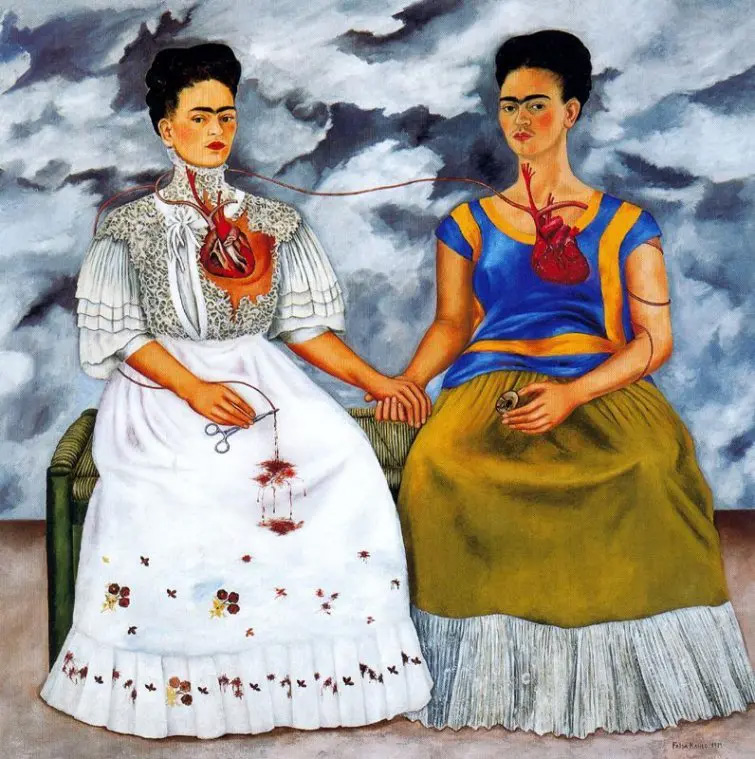
The Two Fridas - Frida Kahlo
By repeatedly revisiting her own image, she used what she knew best to depict the world as she saw it, with unforgettable results.
Another artist that exemplifies creative focus is the Belgian painter René Magritte. Admired as one of the most influential surrealist painters of all time, his origins in commercial painting undeniably made a mark on his style and ability. The repetition involved in creating advertisements and book designs may have influenced him to include it as an essential part of his artistic strategy.
Not only is Magritte known for producing the same image repeatedly, but he also famously produced multiple copies of some of his best-known works. Demonstrating his skill as a painter, and knack for mimicry, he even made a living for a time by selling convincing fakes attributed to other famous artists. He made practice the core of his creative focus, sometimes completing nearly a piece a day. With commitment like that, it’s no surprise that Magritte is one of the most celebrated artists of the 20th century.
Coming from a disparate direction but equally compelling as an artist of profound creative focus is, Pablo Picasso. He repeatedly showed an ability to hone in on a purpose, make it central to his work of the moment, and stay the course regardless of reception.
This quality is exemplified by Picasso’s Blue Period, wherein his works were primarily executed in monochrome. He used the color blue to evoke the mood that permeated his life during the time, diving into loss, despair, and the suffering he saw around him. Though depression fuelled this darkly passionate time, it also yielded some of his most famous works. Again, it wasn’t until later that society offered appreciation, but fortunately, brave artists often follow their convictions without waiting for applause.
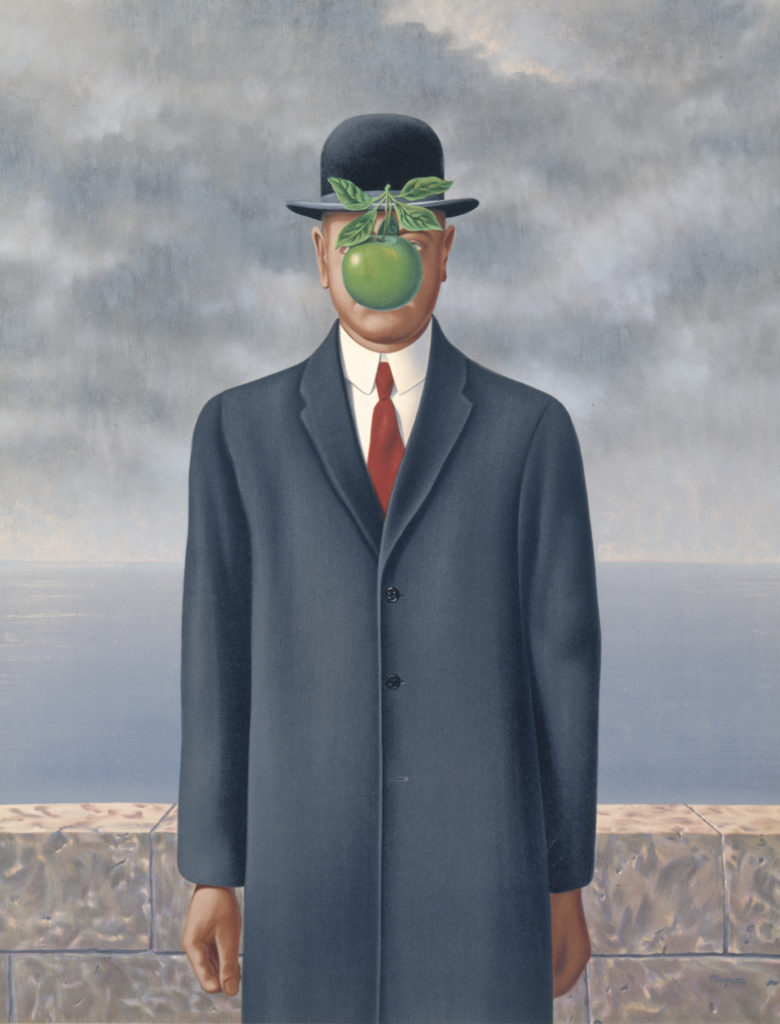
The Son Of Man - René Magritte
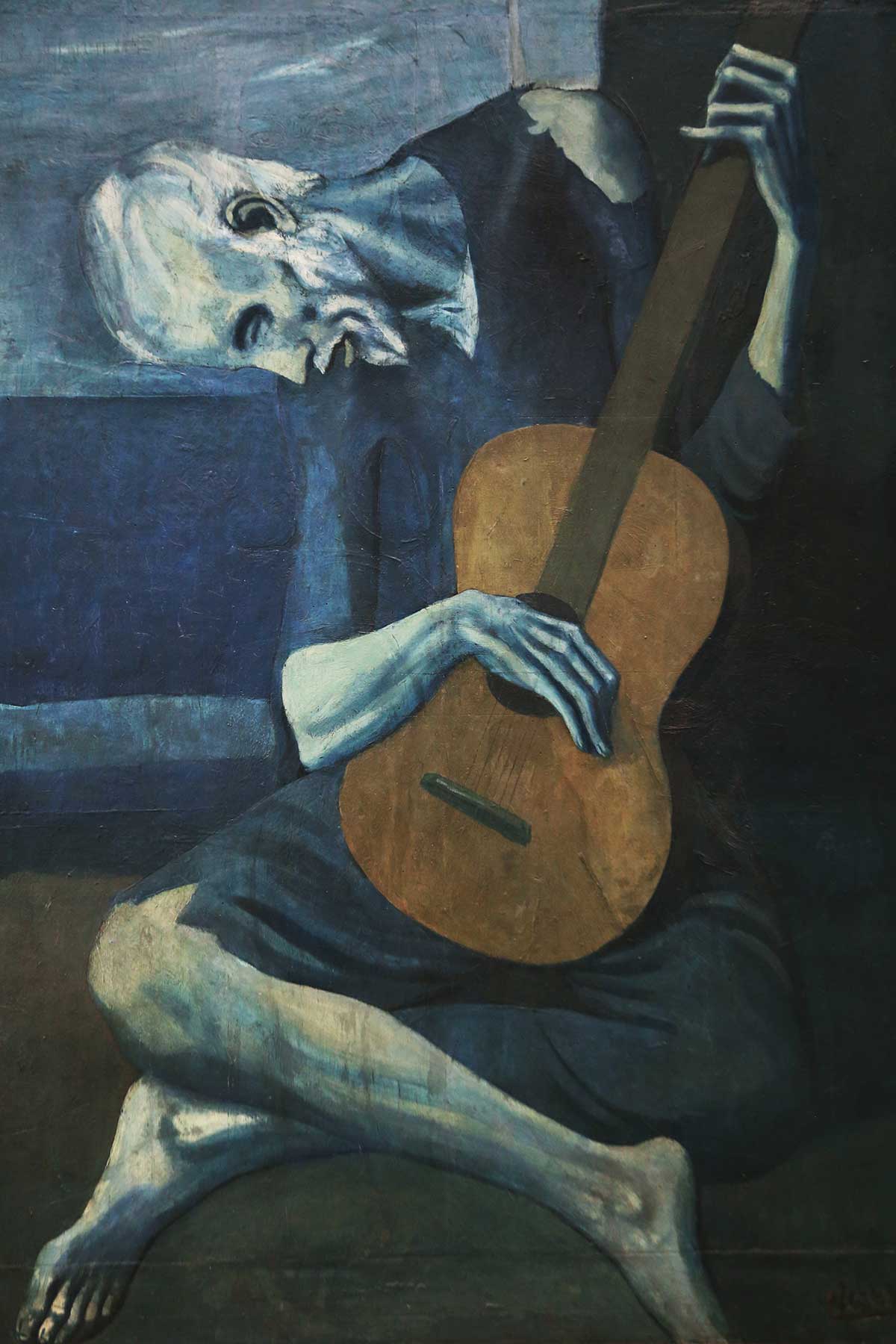
The Old Guitarist - Pablo Picasso
Though we may think of creative focus as being single-pointed, and it sometimes is, it can also be more multifactorial and overarching. Perhaps, like Frida Kahlo, life circumstances such as physical infirmity will lend themselves to practices like still life and self-portraiture, a creative focus born of necessity. Or, perhaps the practical modes of simplifying, distilling ideas, and repetition that your job requires will help you to master your abilities and later become your style and creative focus in the manner of René Magritte. Yet another option is that you may find a mood that consumes you and causes you to explore a single color and the emotions it taps into, like the ever-inspiring Pablo Picasso.
The point is that honing in and employing creative focus is an opportunity to explore the depth of what is possible in a particular creative avenue. This process opens countless doors of expression, helping you to see the world in new ways and nurture fresh perspectives. This experience fosters your ability to bring your creations to life through the practice of exploring individual facets of your art, your being, and your unique voice.
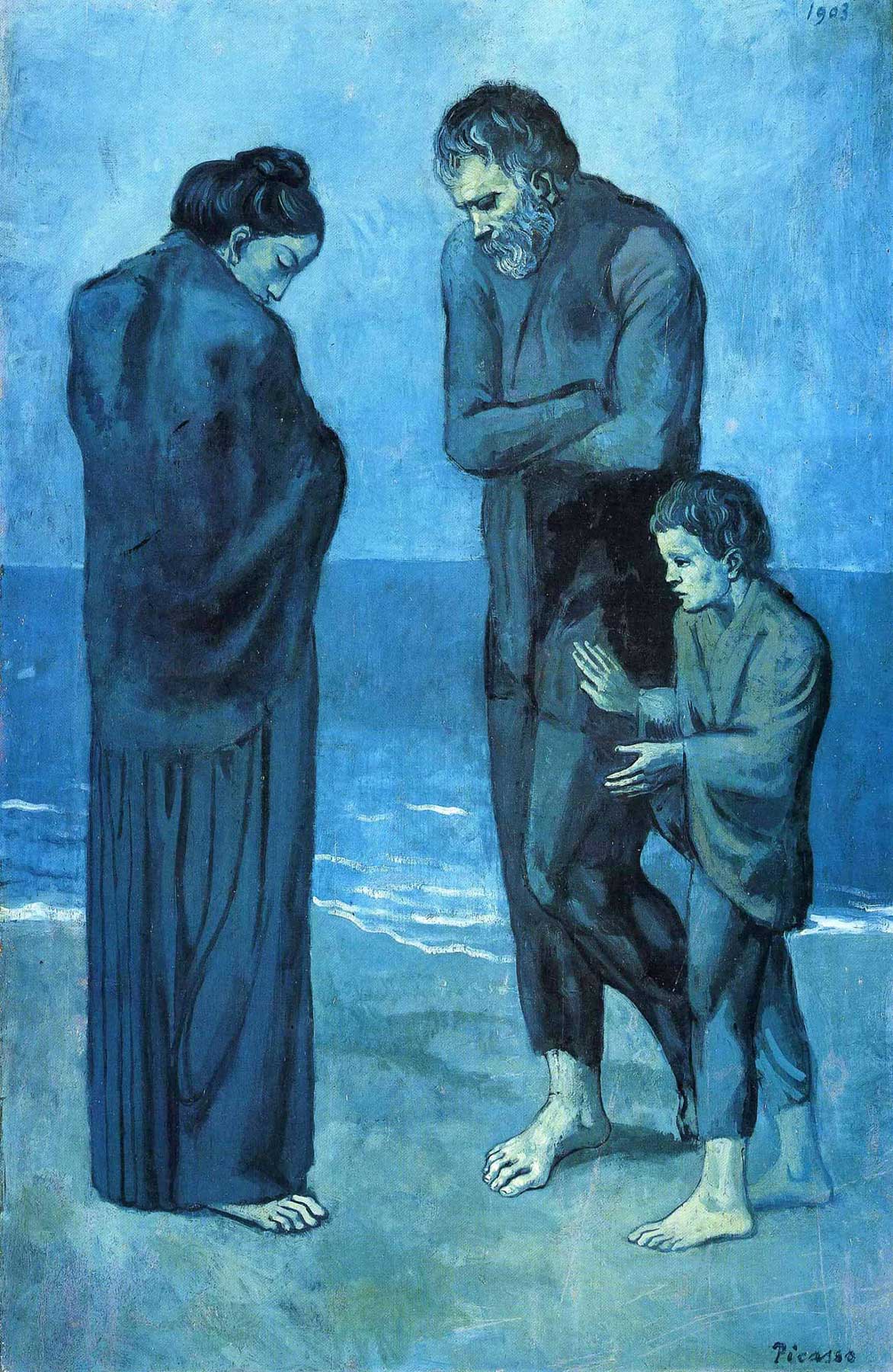
The Tragedy - Pablo Picasso
When we look at the body of work of famous artists, it can feel as though they had it all figured out, and each choice they made logically led to the next, allowing them to naturally develop into the genius they were destined to be. Often, in reality, the process artists undergo as they find their expression is not at all glamorous, predictable, or easy. Many of the most successful artists employed focus and dedication over and over again to hone the skills needed to say what they wanted to say just how they wanted to say it.
Though it would be errant to suggest that there is a precise recipe for emulating a successful process, there are some tried and true methods that enhance artistic ability and promote creativity. One of them is employing creative focus. By zooming in on a style, a technique, a subject, a color, or any type of focused study that calls to us, we gain new skills and insights. We also begin to understand ourselves better, clarifying our personal vision by bringing it into focus.
Starting with quiet reflection is always wise when embarking on any journey. Sit with yourself and openly inquire about what you want to focus on creatively and why. Be patient. If nothing comes up for you, switch gears, think of an artist you admire, and look into what sort of practices they regularly did. Feel free to emulate. The goal is to get the ball rolling.
Once you’ve determined what your focus is going to be, make a commitment to yourself to carve out the time to implement it. Put it in your calendar and make it a non-negotiable. Be realistic, but also be firm.
Suppose you can only dedicate 15 minutes a day, fine. If it works better to do 30 min every other day, that’s also fine. The important thing is to dedicate yourself and show up for the activity repeatedly. It doesn’t take long to create new neural pathways and begin to develop muscle memory. Before long, you’ll have developed a new skill.
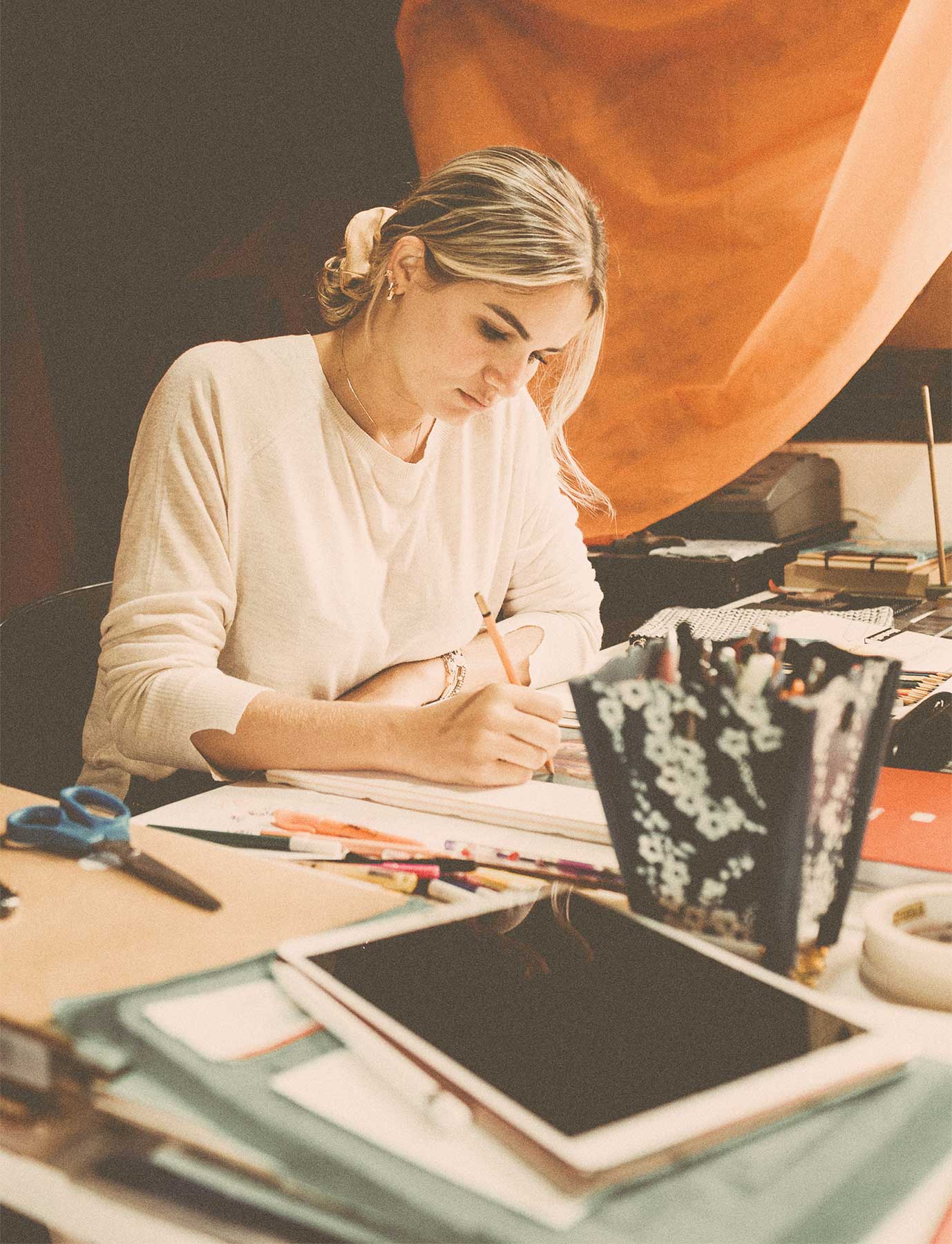
At the beginning of a process, initial enthusiasm can take us a long way. Over time, our energy can sometimes flag, and excuses for skipping the work might creep in. This doldrum can lead us to science. It might sound counterintuitive to use logic to get creative. Still, those people in lab coats have done exhaustive studies on creativity and uncovered a blueprint of the primary traits of creatives.
Skipping the dry details, let’s jump into the boots-on-the-ground behaviors we want to be fostering:
Openness to new experiences. Creativity means being curious, exploring, and flipping your perspective to see things in new ways.
Dream more. By tapping into hypnagogia, the space between sleep and waking, we can access unusual shapes, sounds, colors, and combinations of things that bring freshness to our work. Daydream too, and do so with purpose, freely exploring both fantasies and the fantastic.
Spend time in nature. Being amongst living things in forests, by rivers, in the mountains, or by the sea fosters creative thinking. Extra points if you daydream while outside.
Do the work. Regularly engaging in creative acts builds creative muscles, don’t let them atrophy!
Brainstorm ideas and jot them down. Exploring different territories opens new creative frontiers; the wilder, the better!
Revisit former ideas. Just because you had an AHA moment doesn’t mean the idea doesn’t need tweaking and critiquing. Likewise, something that once felt stale, childish, or just plain off might actually hold some value. Moods change and perspectives too, be willing to adapt.
Implementing creative focus means both fostering our ability to create by keeping the creative juices flowing and simultaneously being willing to put in the time, repetition, and, dare I say, work that focus entails. To progress in our art, we need to make it a priority, even when that challenges us.
The payoff is that we become more skillful in creating what our minds conjure and birthing it into the physical realm while simultaneously building a more extensive toolkit for tomorrow’s inspired visions. By zooming in and fostering creative focus, we develop the ability to do justice to the artist within us.
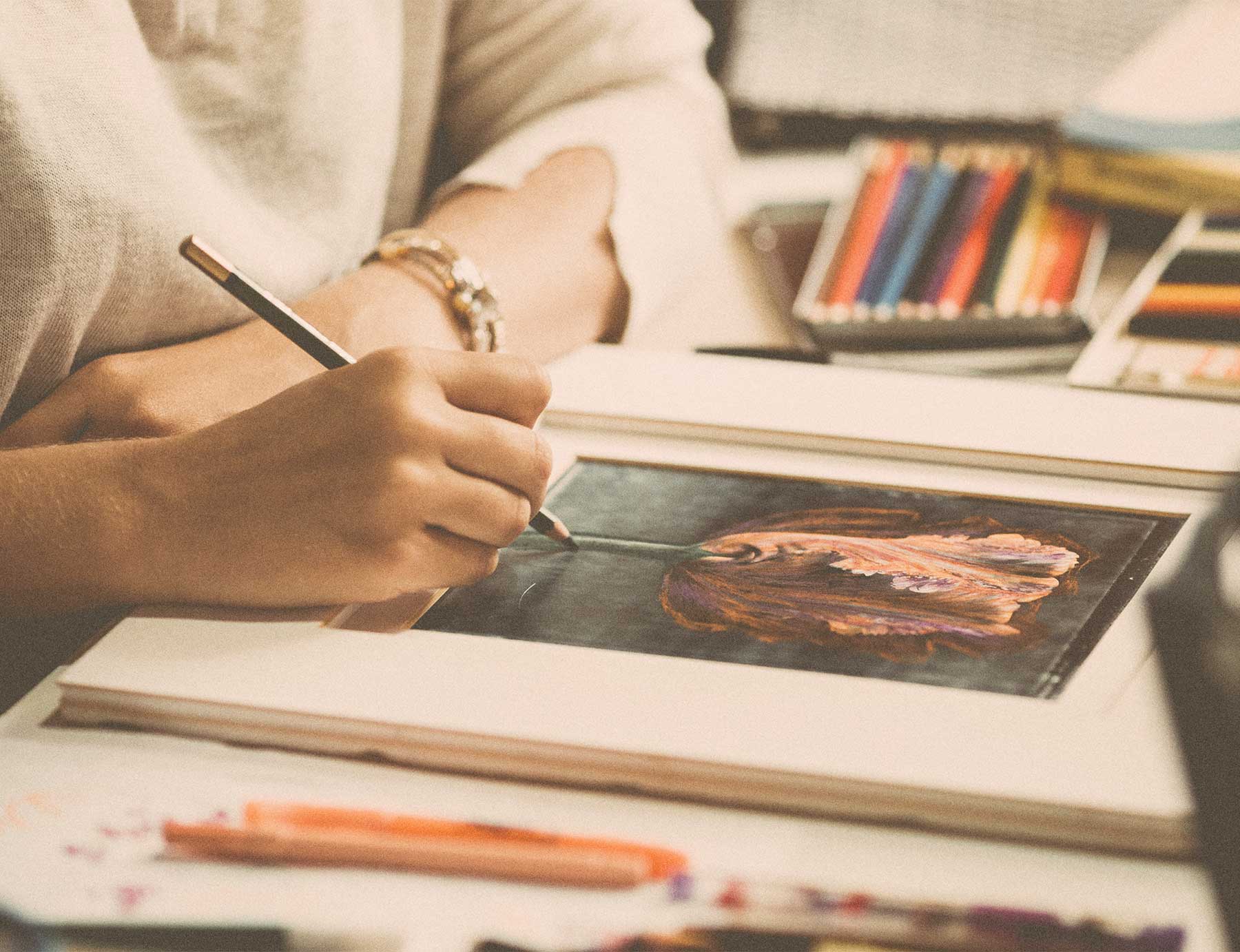
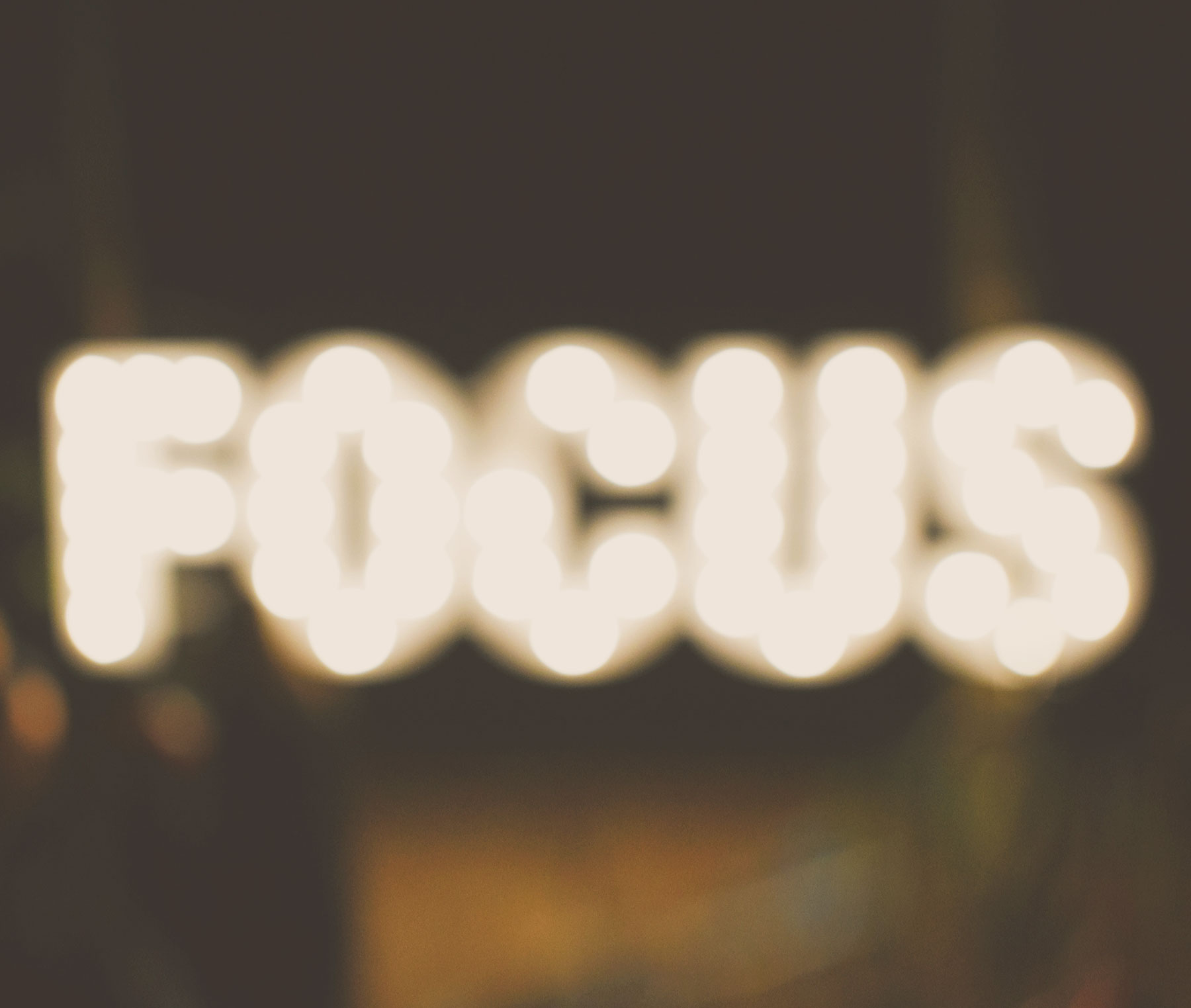
The act of focusing encompasses more than just the physical act of seeing clearly; it's about mental clarity, dedication, and refining one's attention to detail. When an artist aims to hone their skills:
Center of Interest or Activity: Artists often focus on a particular medium, subject, or style, making it their center of interest. By immersing themselves in that specific area, they can delve deeper and refine their skills more effectively.
Clear Visual Definition: An artist needs to have a clear vision of what they want to achieve. Whether it's mastering a technique or conveying a particular emotion, having a focused visual goal will guide their efforts.
Paying Particular Attention: Just like focusing a lens, an artist who focuses their mind can better discern nuances, subtle details, and areas of improvement. They dedicate their time and energy to their craft, pushing away distractions and diversions.
Adjust and Fine-tune: The act of focusing is iterative. An artist continually evaluates their work, fine-tuning their techniques and approaches, just as one might adjust a lens to get the perfect shot.
In essence, focus is an artist's compass. It provides direction, clarity, and a pathway for growth. Without focus, even the most talented artist may find themselves drifting aimlessly, whereas with focus, continuous growth and mastery become attainable goals.
Get those journals and sketchbooks out and get ready to do some self-reflection and writing. Try not to judge what comes out of these writing sessions. Don’t worry about punctuation or grammar or any of that. You can even just make lists if that suits you better. Remember, journaling is a deeply personal practice, so feel free to adapt these prompts to better suit your own thoughts and experiences.
Take a moment to get quiet. Still yourself by doing some gentle breath work. Light a candle. Now ask yourself some questions to reflect upon -
Engaging with these prompts can provide clarity and actionable insights to help us nurture and sharpen our focus, guiding us towards more purposeful and profound artistic expressions.
Remember, journaling is an opportunity for self-exploration and introspection, so feel free to express yourself openly and authentically. Use these prompts as starting points to delve into your creative process and the unique journey of collage-making. Happy journaling!
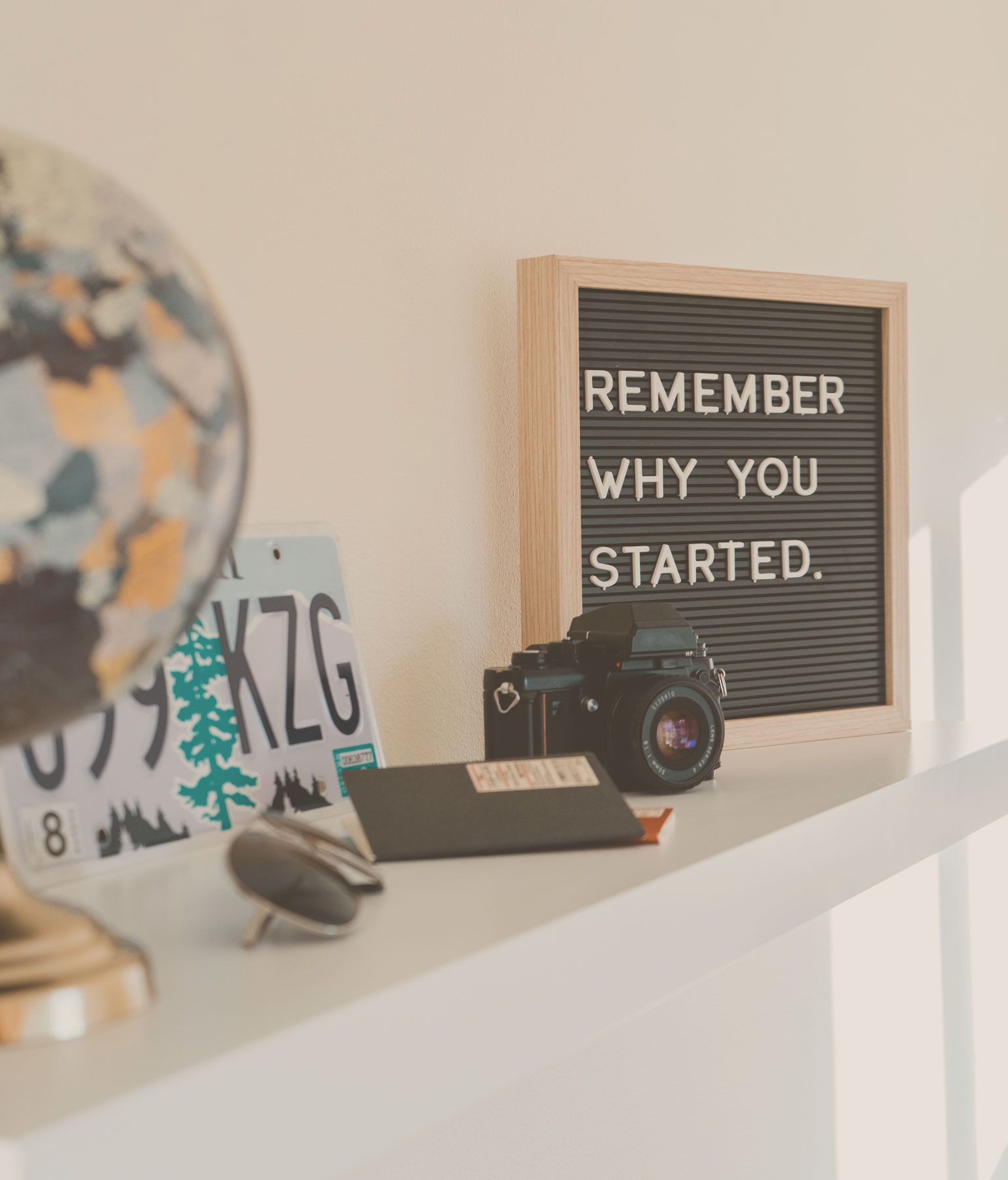
In an era dominated by digital screens and constant notifications, us artists often find ourselves caught in a whirlwind of external influences.
Every swipe, click, and double-tap on social media platforms exposes us to a myriad of visual inspirations, artistic trends, and feedback. While this interconnectedness can offer abundant inspiration, it can also lead to artistic overwhelm and a blurring of one's unique voice. Taking a hiatus from social media might just be the palate cleanser we need to re-center and rediscover our authentic creative core.
1. Reducing Overstimulation - The sheer volume of content on social media can be overstimulating. Every image or video is a potential source of inspiration, but also a potential point of comparison. Breaking from this ceaseless influx allows us to quiet the noise and declutter our mental canvas.
2. Combating Comparison Fatigue - Even without intending to, we can fall into the trap of comparing our work to every piece we encounter online. This continuous juxtaposition can lead to self-doubt and creative paralysis. Disconnecting from these platforms offers a breather, allowing creatives to value our own journey and growth without the weight of constant comparison.
3. Reconnecting with the Self - Away from the clamor of likes, shares, and comments, we can more readily tune into our inner dialogues and emotions. This self-reflection can guide us back to our personal "why", reminding us of the reasons we ventured into the world of art in the first place.
4. Rekindling Organic Inspiration - Nature, books, personal experiences, and offline interactions often hold potent sources of inspiration. A hiatus from social media pushes us to seek and recognize these offline muses, grounding our work in raw, unfiltered experiences.
5. Refining Focus - Free from the pressure of frequent posting and audience engagement, we can dive deeper into our projects. We can indulge in prolonged periods of focus, refining our skills and concepts without the itch to showcase snippets of this process prematurely.
Look, I get it, while social media offers us a platform to share, connect and draw inspiration, periodic breaks can be incredibly rejuvenating. It provides an opportunity to step back, re-evaluate, and rekindle a personal connection with our art. In the silence away from the digital buzz, we often find the loudest echoes of our authentic selves. And in that authenticity, true creativity flourishes.
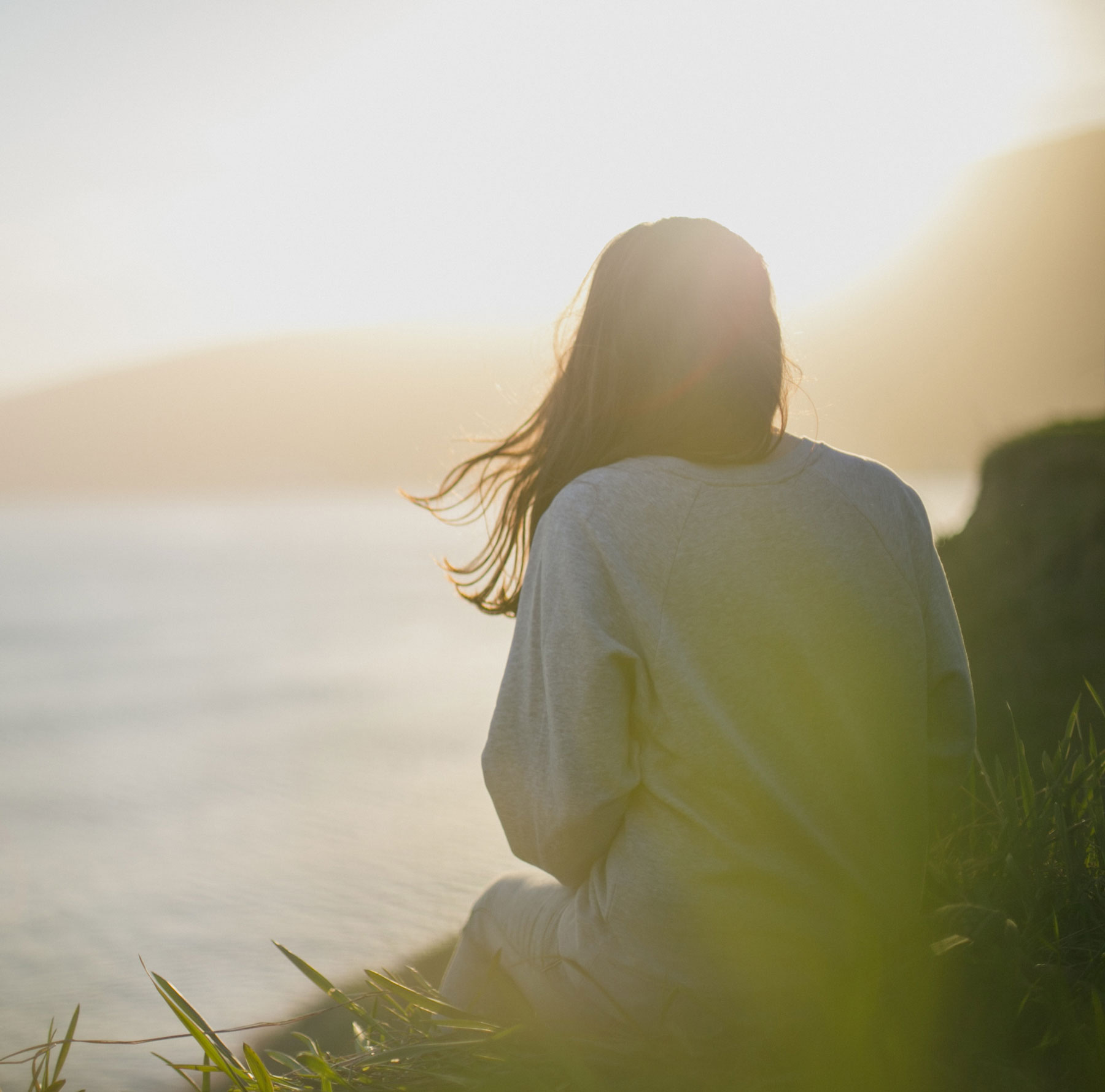
I am sharing this beautiful energy experience session from one of my favorite meditation masters - Rachel Hillary. This journey will help you to feel more peaceful and connected to self. In nature, we can hear the whispers of our inner guide. Listen closely. What you need to focus on in your creative life will arise and become clear. Give yourself some quiet time to enjoy this beautiful meditation.
Rachel will share a little about this experience -
This guided practice for grounding takes place deep in the lush green forests, full of animals and magic. As we connect together to the roots of earth magic, this energy is channelled through for you to receive and to embody after the meditation is over. We meet an animal guide, with messages of love and earthly mystery for you, allowing space for you to connect. This simple and steady exercise is full of magic, and earthy green tones that are ready to flow through you. Please note: there is no ending bell, the music simply plays on for a few minutes and then fades out.
lots of love,
Rachel
Each month we will have a positive affirmation. I recommend you print out this affirmation and put it in your sketchbook or somewhere in your studio. Recite the affirmation out loud each time you show up to create. Saying words aloud is powerful and can begin to re-write some of our own limiting beliefs or calm our fears. Try it now…
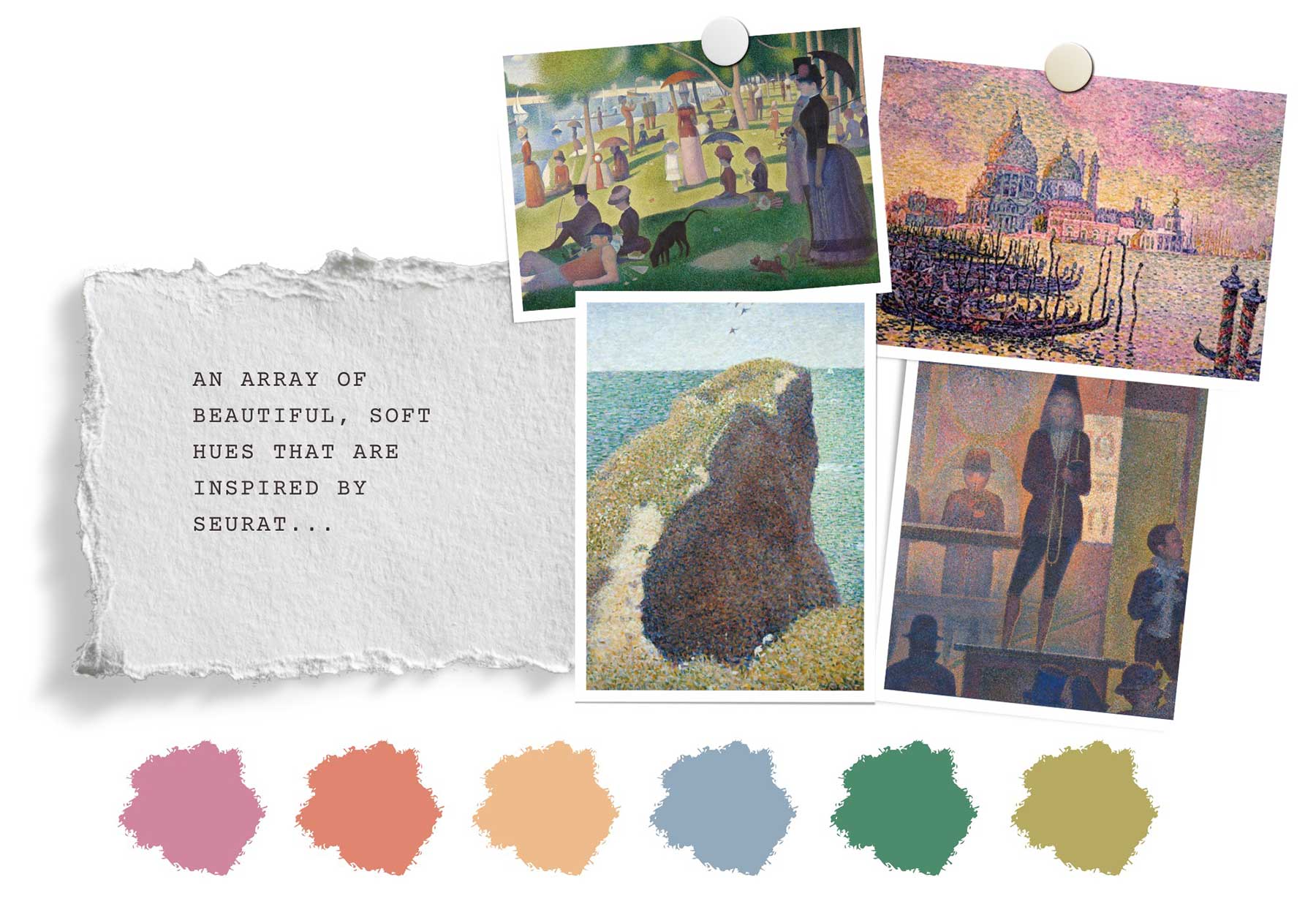
While we usually designate a specific color palette for the month based on our chosen Master Artist, I feel with our theme being “focus” that perhaps, you should pick your own palette.
Plus, our Master Artist - George Seurat - was completely obsessed with color and didn’t necessarily focus on one particular color range but rather explored color and color theory with an intense fascination and focus. However, let me give you some guidance on how you might choose your own color palette to play with for this month.
Colors have a way of speaking to our souls, evoking emotions and memories, and inspiring creativity. For us artists, aligning with a set of colors that truly resonates can invigorate our work and deepen our artistic voice. But how do we discern the hues that truly call to us?
Consider what colors you are drawn to. What colors do you consistently reach for when creating? What colors do you wear? What colors excite you or create a sense of peace or inspiration? This is different for everyone.
Look at other artists you love, explore their colors. Could you use them in your own work more? I would recommend creating a few pages in your art journal documenting this. Or make a Pinterest board of your favorite color combinations. Pick one palette and focus on it all month long. Define clearly, to yourself, what this palette is. Swatch it up in your art journal or sketchbook. Lean into it and let it guide your to new discoveries, while you hone your skills.
I did create a lovely BIG Pinterest board of color palette inspiration for you too! Check it out below...
Those of you who own our ColorFlow cards and/or books can also refer to these great resources for hands-on color inspiration.
Welcome to our monthly Master Artist Study. As we embark on this journey, we'll traverse the textured terrains of Seurat's works, diving deep into his methodological approach, understanding the nuances of his Pointillism, and reflecting upon the indelible mark he left on the world of art. Through Seurat's dots, we'll find a universe of expression, innovation, and timeless beauty. Together, lets explore his unwavering focus on the study of color.
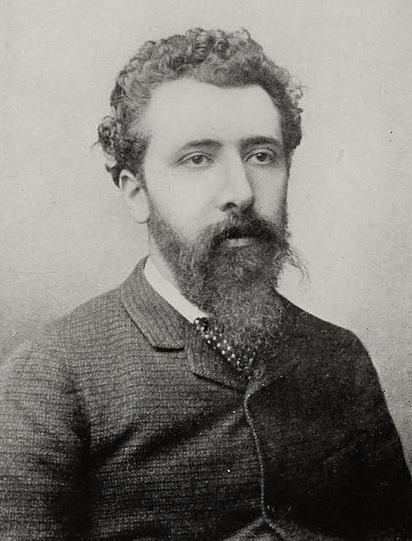
In the vast tapestry of art history, certain names echo louder than others due to their transformative influence. Georges Seurat, a pioneering force behind the Post-Impressionist movement, stands tall as a testament to this legacy, with a life story as vivid as his pioneering works.
Born into the artistic milieu of Paris on December 2, 1859, Seurat was destined for the world of colors. His family, while affluent, maintained a simple lifestyle, allowing young Seurat the freedom to immerse himself in his passions without excessive familial pressures.
Trained under the meticulous eye of Henri Lehmann at the École des Beaux-Arts, Seurat absorbed the traditional methods and ideals of art. However, his true genius lay in his ability to diverge from the established norms. The young artist showed not just an interest, but an obsession with color theory, optics, and the science behind visual perception.
This deliberate focus on color culminated in the revolutionary technique of Pointillism. Instead of mixing pigments, Seurat placed tiny, individual dots of pure color side by side on the canvas. This method, deeply rooted in his understanding of the science of optics, allowed the viewer's eye to blend the colors, creating a luminosity and vibrancy previously unseen.
His magnum opus, "A Sunday Afternoon on the Island of La Grande Jatte," is perhaps the most vivid exemplar of this technique. Two years in the making, this painting showcased not just Seurat's artistic prowess but his methodical, almost scientific approach to art.
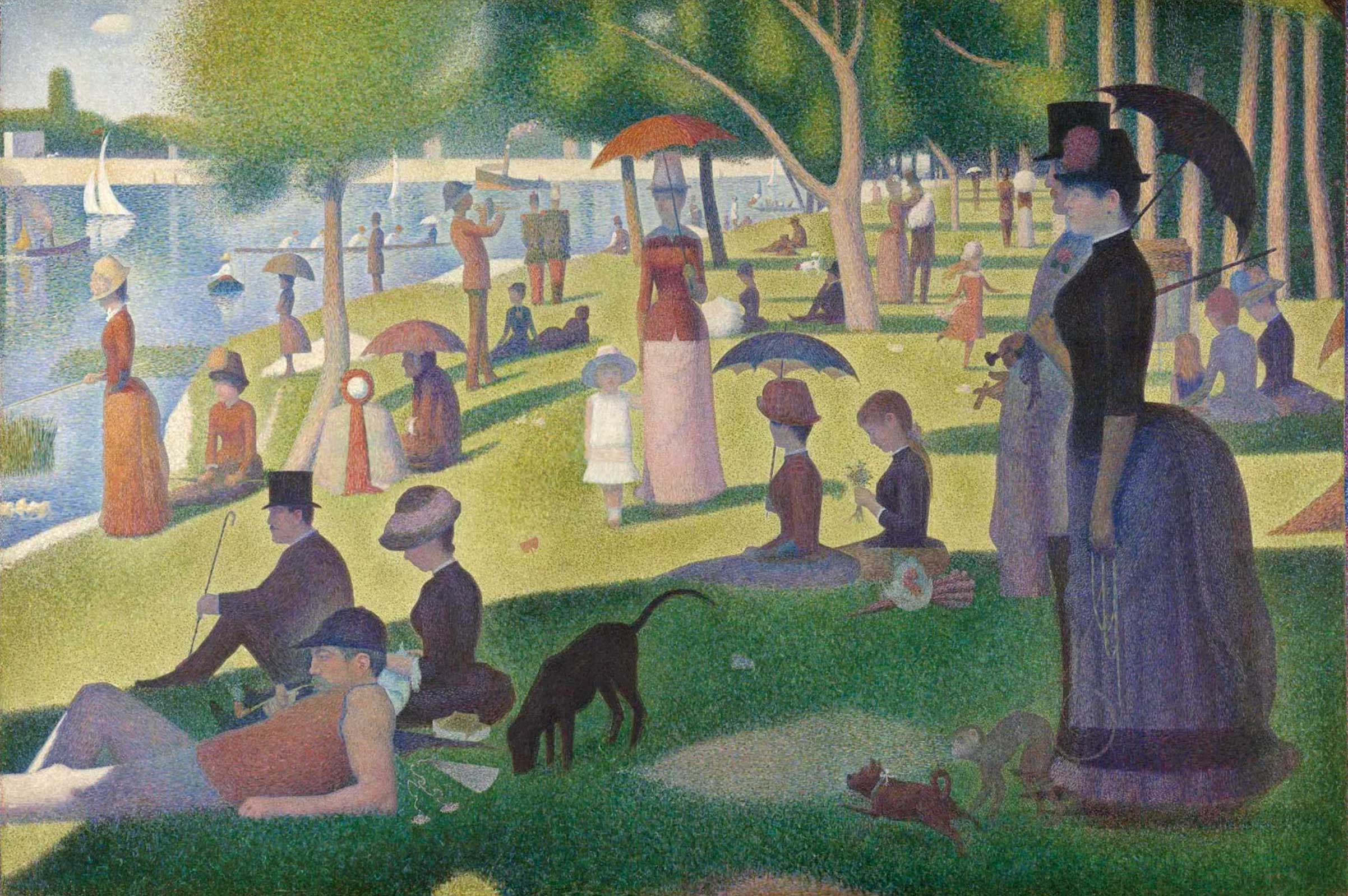
Seurat's life was emblematic of his art – precise, methodical, and intensely focused. While his contemporaries like Van Gogh or Gauguin ventured into abstract emotional expressions, Seurat remained steadfast in his exploration of the tangible and scientific aspects of painting.
Even in his personal life, Seurat was a man of few words, preferring the company of his colors and canvases to social frivolities. His relationship with Madeleine Knobloch and the birth of their son, Pierre-Georges, was kept under wraps, indicating his penchant for privacy and perhaps a desire to remain undistracted from his artistic pursuits.
Tragically, Georges Seurat's life was cut short when he died in 1891 at the age of 31. The cause remains a matter of speculation, ranging from infectious diseases to complications from untreated illnesses.
Yet, in his brief time, Seurat transformed the world of art. His unyielding dedication on color theory and his innovative techniques bridged the gap between traditional art and the burgeoning world of modernist expression. Today, his influence reverberates not just in galleries and art schools, but in the very way we perceive the relationship between science, color, and art.
In the end, Georges Seurat's life serves as a vivid reminder of the power of dedication, precision, focus and an undying passion for one's craft.
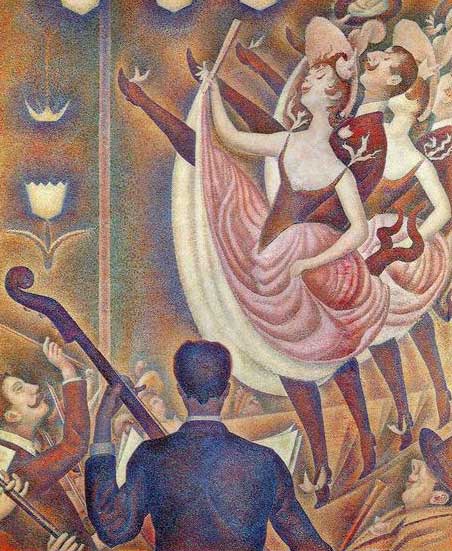
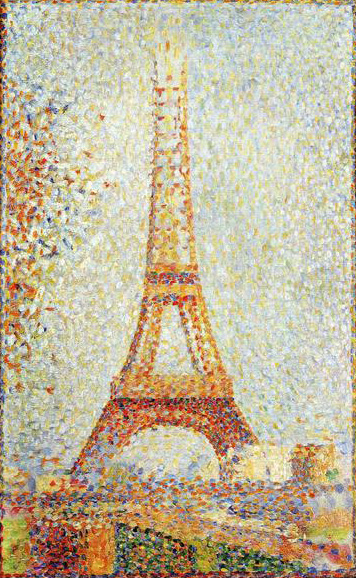
Georges Seurat's artwork is renowned for its innovative techniques and profound influence on the trajectory of modern art. Some of the key elements that define his work include:
Pointillism: Without a doubt, Seurat's most significant contribution to art was his development of Pointillism. This technique involves applying tiny dots of pure color to the canvas, which from a distance, merge in the viewer's eye to create a cohesive image.
Color Theory: Seurat's works are deeply rooted in scientific studies of color and optics. He was profoundly influenced by contemporary scientific theories on color juxtaposition and how colors are perceived by the human eye. This knowledge was systematically applied in his works to create the desired effects.
Structured Compositions: Unlike many of his Impressionist contemporaries who used more spontaneous and loose brushwork, Seurat's compositions were methodical, carefully planned, and often geometrically structured.
Atmosphere and Light: Though he approached it differently, like the Impressionists, Seurat was deeply interested in capturing the essence of light and atmosphere. Through Pointillism, he could manipulate the interplay of colors to portray different times of day and atmospheric conditions.
Urban and Natural Scenes: Many of Seurat's notable works, such as "A Sunday Afternoon on the Island of La Grande Jatte," depict leisure activities in urban and suburban settings. However, he also had a number of pieces capturing more natural landscapes and coastal scenes.
Influence of Divisionism: Divisionism is a broader term than Pointillism and pertains to the separation of colors into individual dots or patches which interact optically. Seurat's approach was a meticulous manifestation of this idea.
Flatness and Contour: Seurat often rendered figures with a certain degree of flatness, focusing more on contour and less on three-dimensional modeling.
Narrative Detail: Seurat's works often contained intricate narrative details, depicting both the bourgeoisie and working-class individuals in moments of leisure or work.
Influence from Classical Art: Seurat admired classical art and sculpture, and this can be seen in the posed nature of figures in some of his compositions, giving them a timeless quality.
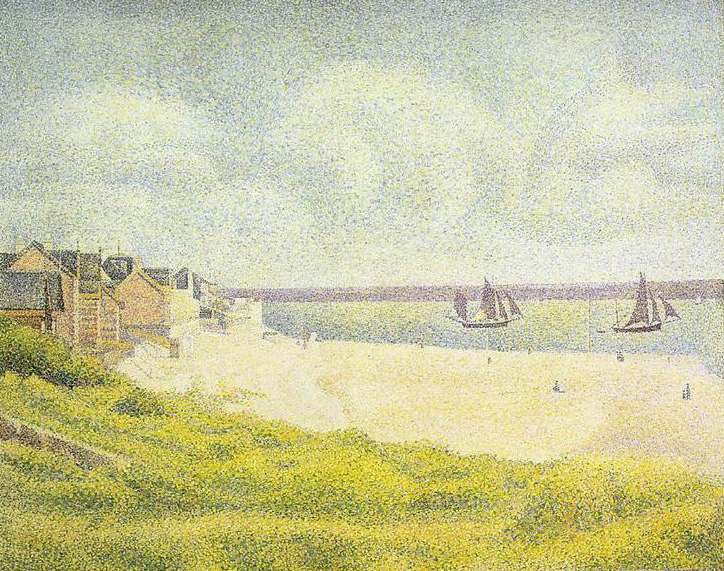
It is an innovative painting technique and artistic style developed in the late 19th century, primarily associated with Georges Seurat and Paul Signac. Here's an artistic definition of pointillism:
Definition: A painting technique characterized by the application of paint in small, distinct dots or points. These individual dots, when observed from a distance, optically blend to form images and create a luminous effect.
Origins: Pointillism emerged as an offshoot of Impressionism, specifically as a branch of Neo-Impressionism. While Impressionists were already exploring the effects of light and color in their work, artists like Seurat took this investigation a step further by incorporating scientific theories of color and optics.
Science and Art: The technique is rooted in the contemporary scientific understanding of the time, specifically the ways in which colors optically blend in the human eye. Instead of mixing colors on the palette, Pointillists applied pure pigments directly onto the canvas, allowing the viewer's eye to do the mixing.
Impact and Legacy: While Pointillism was a relatively short-lived movement, its impact on art was profound. It led to a broader understanding of the interplay between individual colors and how they are perceived when placed next to one another. The movement also opened the door to further explorations in modern art, influencing subsequent styles and approaches to color.
Though the process of Pointillism is meticulous and time-consuming, the resulting luminosity and vibrancy of the images are distinct, making the works instantly recognizable.
I think I would choose (pan)pastels. I like their painterly effect, yet I am in much more direct contact with the materials when creating. That works for me - as I am a kinestetic and need to ‘feel’ (touch) my materials. - Tanja van den Broek-Sandmann
Thanks for asking the question, Ivy. I’m trying to be more digital orientated but get frustrated that it takes me longer to do on anything on an iPad than it would with physical materials. I’m generally a mixed media dabbler and love the tactile aspect of it too, but I really need to focus on digital practice and transitioning away from physical supply stashes. - Nikki Farquhar
My focus is watercolor right now and creating a practice that’s doable and becomes a real part of my day. It’s amazing how quickly 20 or 30 minutes adds up in work produced and skill level, not to mention what it does for me mentally. My watercolor journal is filled already and I’m on to the next and I’m loving it. - Monica Stadalski
Oil painting especially landscapes ,looser ,impressionistic but not too vibrant ,calming pastoral scenes ..I need to get away from saturated art ,there’s been a lot these days ..I need quiet ,serene. - Elizabeth Mitchell
I think that I would focus on layering techniques and personal narrative. Telling a story through my art is becoming important to me. - Christine O'Brien
I would say my current area of focus is a combination of technique and medium. I’m in a period of process, experimentation, practicing my skills and learning new ones across all of my preferred mediums, after being out of my studio for so long. - Martha Lyon Barnett
The one area I continually use is sketching. I carry a sketchbook and atleast one pencil in my bag wherever I go. I like the simplicity of it, and that you can fit it in with whatever you are doing (for 5 minutes or sometimes an hour) I also find that its a mindful process to help me focus on the present moment and ground me. - Amanda Jessie Coates
I enjoy focusing on paint selection and mixing colors thinking about their compatibility, cohesion, and impact. - Barbara Haberkorn
If I could I would focus on learn portraits in any medium but preferably collage, I love how a facial expression can convey all kind of emotions, sometimes even mixing “opposite” feelings like devastated but hopeful. - Lucy Lopez
Let’s try a Mindmap in our Sketchbooks to help us find our area of focus (if you are unsure).
Mind mapping is a powerful visualization tool that can help artists (and anyone, really) clarify thoughts, generate ideas, and identify areas of focus. Here's a step-by-step guide on how an artist can use the mind mapping technique to discover their creative priorities...
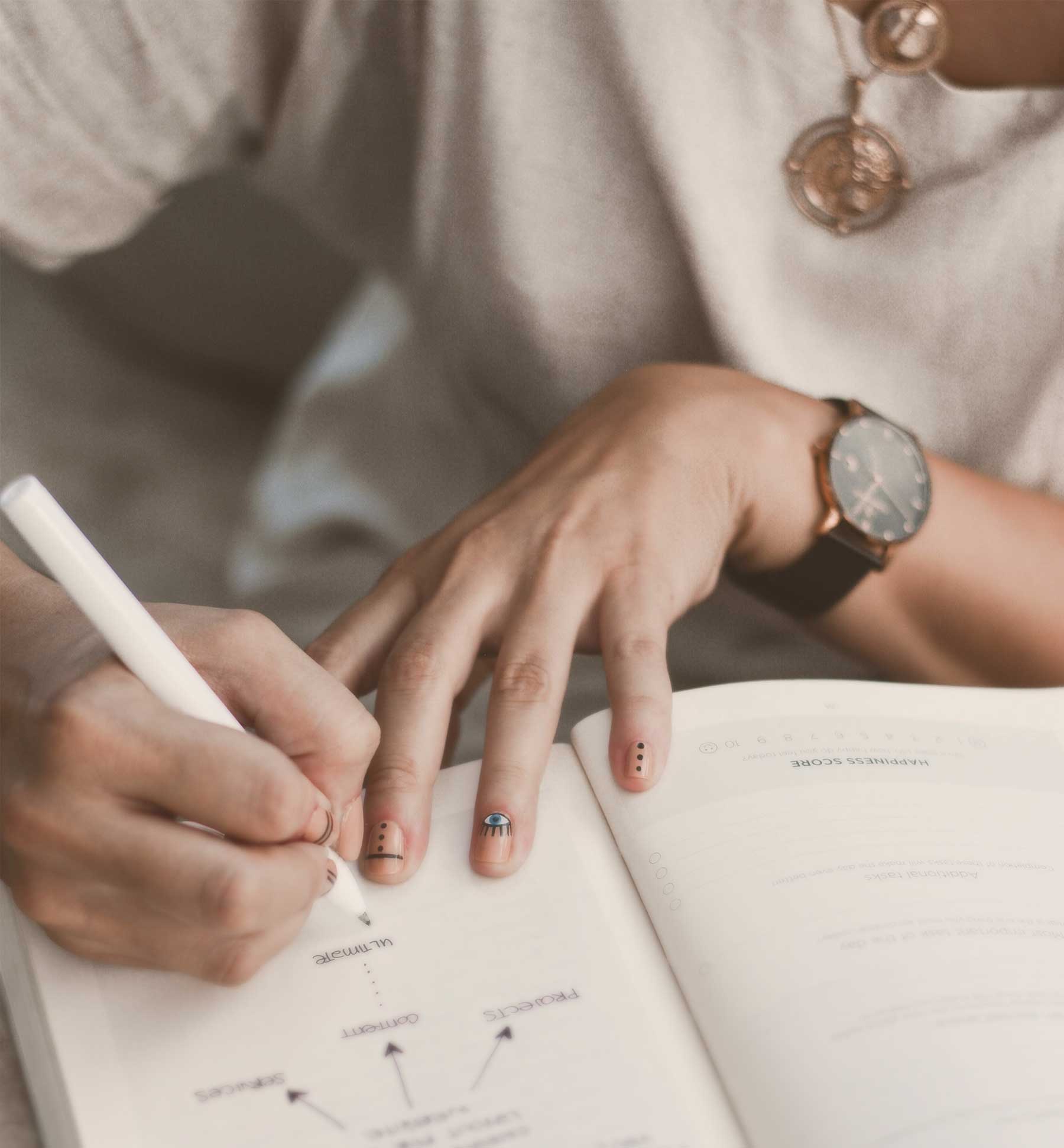
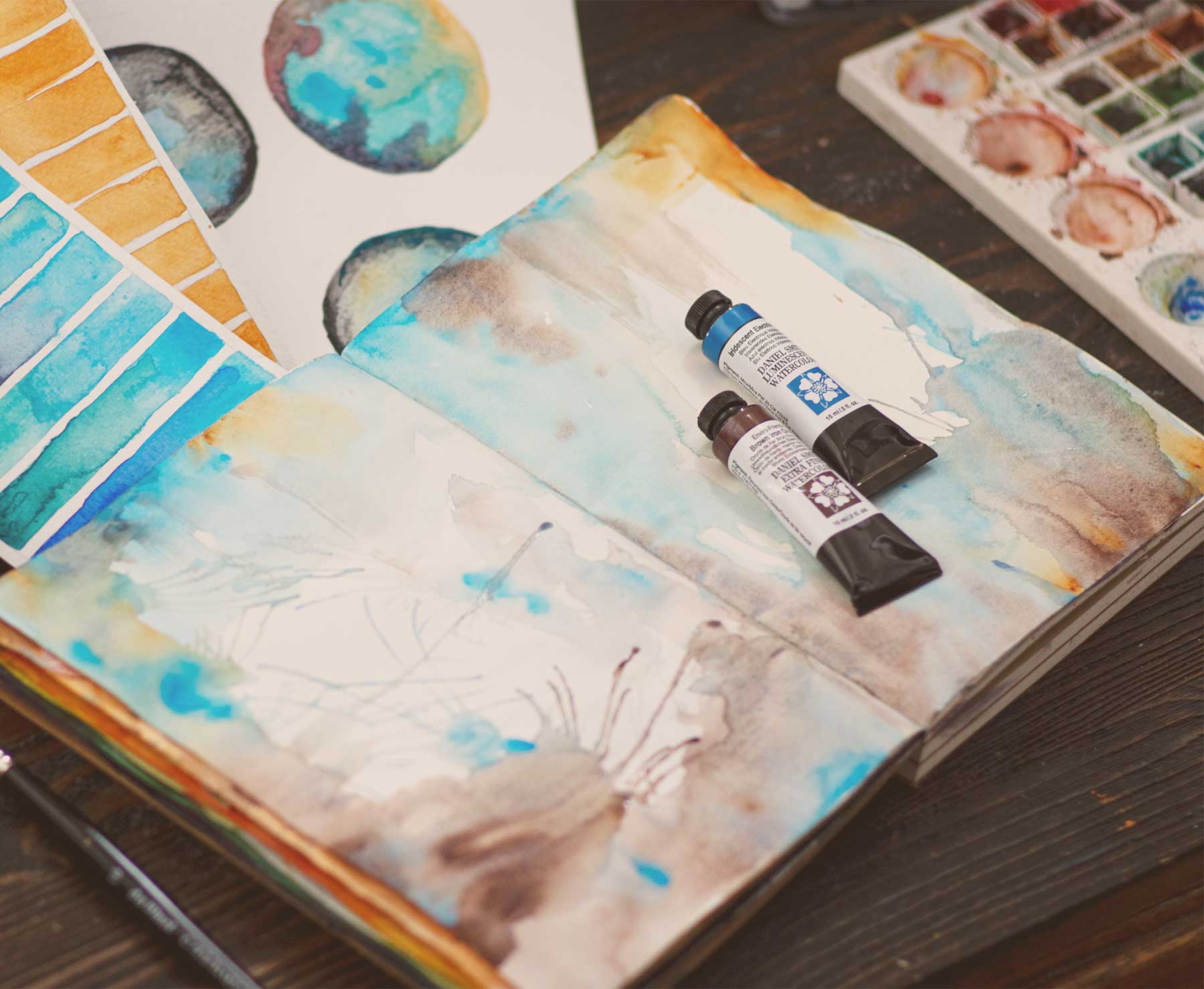
As previously mentioned, I’m encouraging you to pick a color palette or even a single color to focus on this month as we learn to hone our creative intention. Dedicate a page or a few pages swatching these colors and even creating small sketches or paintings using only these hues. Make notes as to why you chose this color palette. Try and see if you can create a number or works in this range only. Set a realistic goal.
Remember I created a color palette inspiration Pinterest Board to help you get started...
Hopefully you found yourself inspired by Georges Seurat’s dedication to the study and focus of color and the evolution of Pointilism. Do a little master study or a small Pointilism painting in your chosen color palette. Allow this to be a meditative practice with the intention of slowing down and being intentional with where you focus your creative energy.
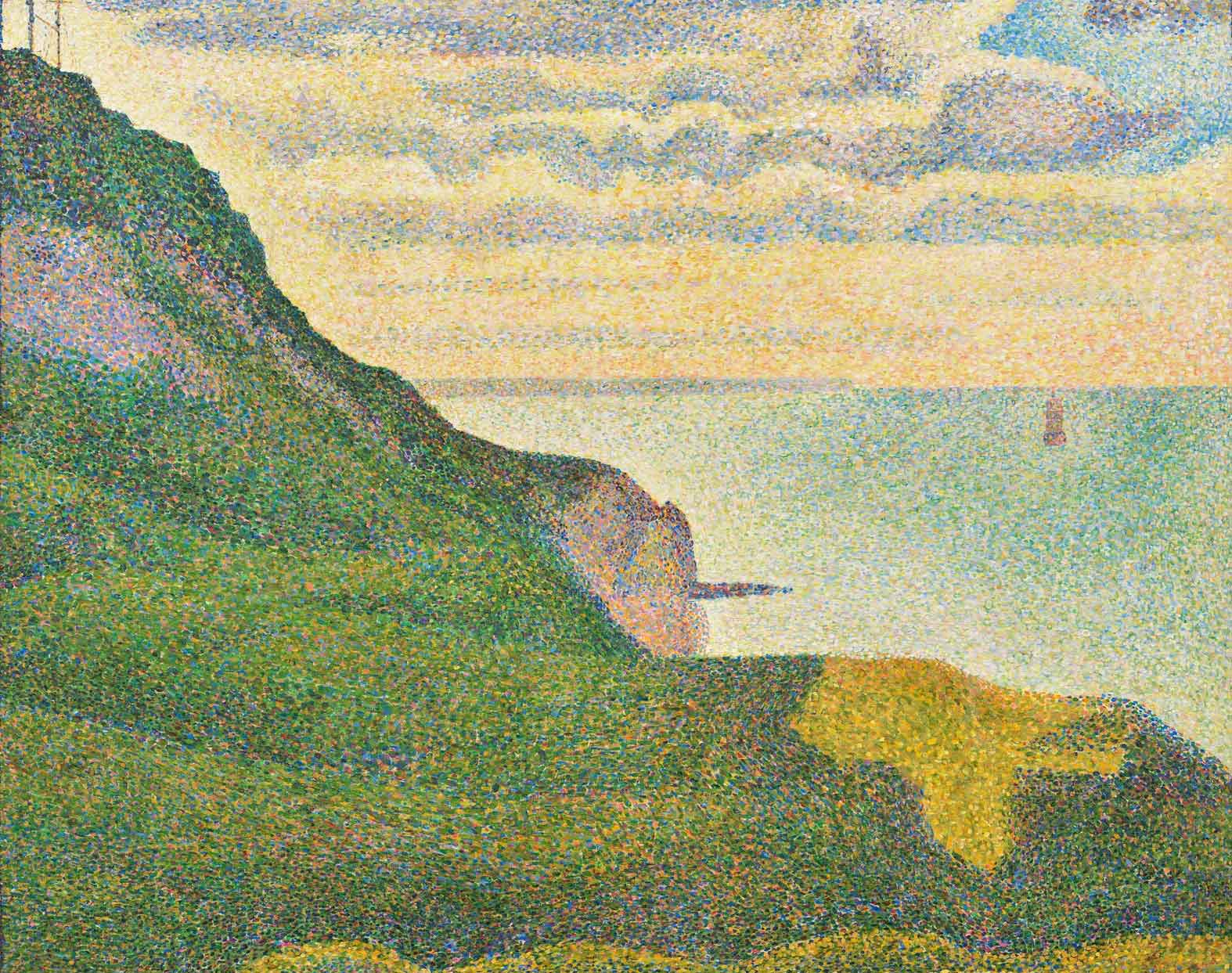
We're excited to have another beautiful lesson by the talented, Natalie Eslick.
This lesson serves as a catalyst for inspiration, empowering us to amplify our creative focus. Natalie champions the relentless pursuit of creativity, urging us to continually enrich our work with intricate details and contrast. She emphasizes the strategic use of darks and lights, advocating for a nuanced interplay of values that makes the bright elements truly stand out. Additionally, she invites us to thoughtfully consider the saturation of colors, offering a multidimensional approach to artistic expression..
It's truly inspiring!
You can also listen to this month’s issue of the Studioworks journal. I find I love listening to books, podcasts and music while I draw, paint or go on a long walk. Enjoy.
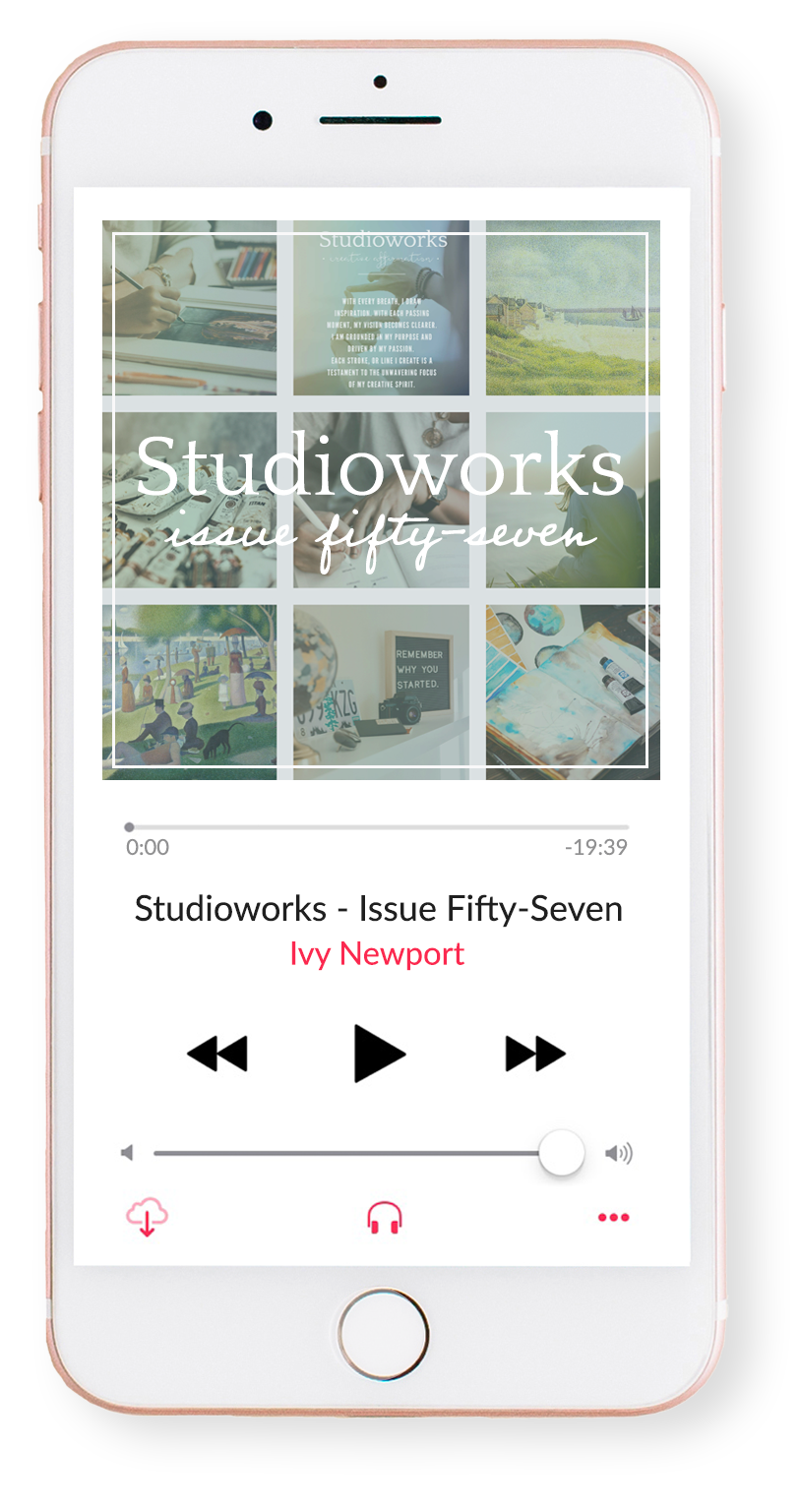

One of my favorite things to do is to curate inspiration. From Pinterest boards to books, resources, playlists and more - I love to share anything that might facilitate learning, expansion, and sparks of curiosity! Being an artist, we naturally crave these things so here are some of this month’s picks from me to you.
I had so much fun curating this list. I hope you enjoy!!
Here are just a few of our fantastic classes! I highly recommend checking them out if you haven’t already. Enjoy!